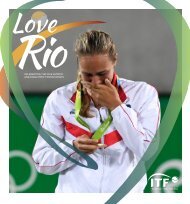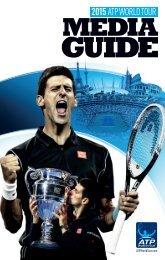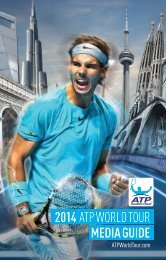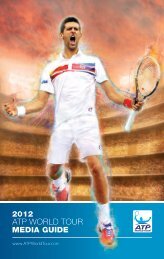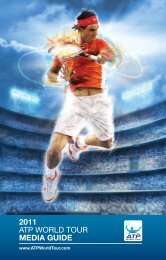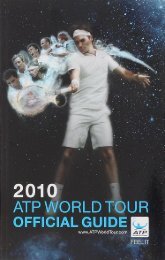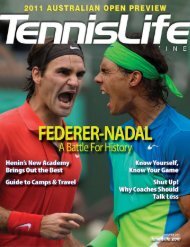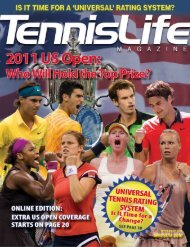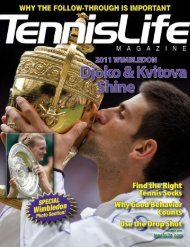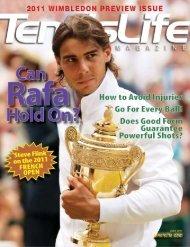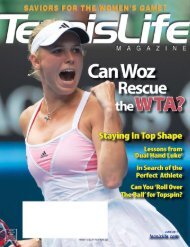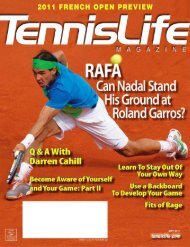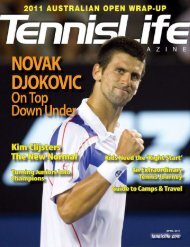A Champion's Mind - Pete Sampras
www.tennismoscow.me Insta:TENNISMOSCOW
www.tennismoscow.me Insta:TENNISMOSCOW
Create successful ePaper yourself
Turn your PDF publications into a flip-book with our unique Google optimized e-Paper software.
The Aussies have a great tennis tradition, yet even their icons tended to be regular, plainspoken,<br />
understated guys, somewhat like me. That was an immediate affinity I felt with Australia. The Australians<br />
also are a friendly, easygoing people, and the atmosphere at their major is laid-back; that also suited me.<br />
You could get gut-shot in the street there and if you crawled up to a guy for help he’d probably say, “No<br />
worries, mate!”—and then do all he could to help. The facilities at Melbourne Park, including Rod Laver<br />
Arena, are modern and first-class. You don’t have that feeling of chaos and crowding that characterizes<br />
the other majors; even the media presence is considerably smaller. So you have a little less of that<br />
intensity and crazy pressure.<br />
My beef with the Australian Open started with the balls. The balls always seemed to play a little<br />
differently down under. It was like they couldn’t decide whether they wanted a fast, hard ball or a soft,<br />
slow one—one that fuzzed up like a kitten, or had a tighter, shorter nap and flew faster. One year the balls<br />
left little black marks on the composite surface, like you see on a squash court.<br />
In Melbourne, you could always count on a few days when the temperature pushes the one-hundreddegree<br />
mark, and even though it isn’t very humid, the heat can be draining. It was a special problem for<br />
me, because I secretly suffered from thalassemia, a mild disease common to men of Mediterranean<br />
descent. It’s basically a blood-iron deficiency that causes anemia, and those who have it are prone to<br />
wilting in intense heat. I knew thalassemia ran in my family, but chose not to deal with it until fairly late in<br />
my career. Curiously, the guys who did best down under were the Swedes—people from a cold northern<br />
climate who appreciate and love the sun and its heat in the winter. The Russians are usually competitive<br />
there, too.<br />
Another unpredictable thing about the courts at Melbourne Park was the Rebound Ace surface (which<br />
was replaced by Plexicushion for 2008). Rebound Ace was a rubber compound that they painted over the<br />
typical hard-court base of asphalt. The surface provided a little cushioning and slowed the bounce, but it<br />
did strange things in the heat. It was so hot in Melbourne one year that a TV crew cracked an egg on a<br />
court and, using time-lapse photography, recorded it frying. The heat made the Rebound Ace very sticky.<br />
Gabriela Sabatini once blew out an entire tennis shoe while making a change of direction (the shoe stuck<br />
and tore as she pushed off). Others took nasty tumbles and turned ankles.<br />
Yet the conditions in Oz can change in the blink of an eye. The difference between playing day and night<br />
matches there is huge (the Australian and U.S. opens are the only two majors that have night tennis, and<br />
the retractable roof over the Laver Arena means you can have night indoor tennis). The surface reacted<br />
easily to ambient changes of any kind; it was simply a different court when the temperature was a<br />
comfortable seventy-five or eighty degrees—which was often the case during the night matches that<br />
followed scorching afternoons. To me, the Australian major was a crapshoot in the areas where I most<br />
preferred consistency—the surface, the balls, and the ambient conditions.<br />
In Australia in 1996, on the anniversary of Tim’s collapse, all the old wounds associated with that event<br />
were reopened. So I didn’t really mind leaving Melbourne and putting all that behind me. Back at home,<br />
Tim was going downhill fast. I frequently found myself taking stock and realizing what I was losing.<br />
When you’re a top player instead of just a guy hell-bent on improving and figuring out your game, you<br />
are not hiring a coach purely for his command of the x’s and o’s. Those are usually sorted out in the first<br />
six or eight months. After that, it’s all about how you interact with and influence each other; it’s about the<br />
confidence and trust you build, and about loyalty.<br />
By the time Tim collapsed, our relationship was about things other than how to return on grass, or how<br />
to throw your chest out in a Grand Slam final. But I didn’t really think about that part until after he became<br />
ill. Tim had gradually become my stability—the guy I talked to (to whatever degree I talked), and in<br />
whom I confided in my own limited way.



